
As an artist I am interested in social themes. In Lungau I have focused on the 'rural flight'. That's what it's called when young people exchange the countryside for the big city. This beautiful region in Austria has a rich cultural past but how about its future? During the Supergau Festival I initiated site specific 'Conversation Pieces' to imagine and debate the future.
Project pages in:
Dutch, English, German
Where:
Lungau region, Austria
When:
2022 - 2023
In collaboration with:
The people of the Lungau region and the team of Supergau for contemporary arts
Made possible by:
Supergau for contemporary arts, Land Salzburg
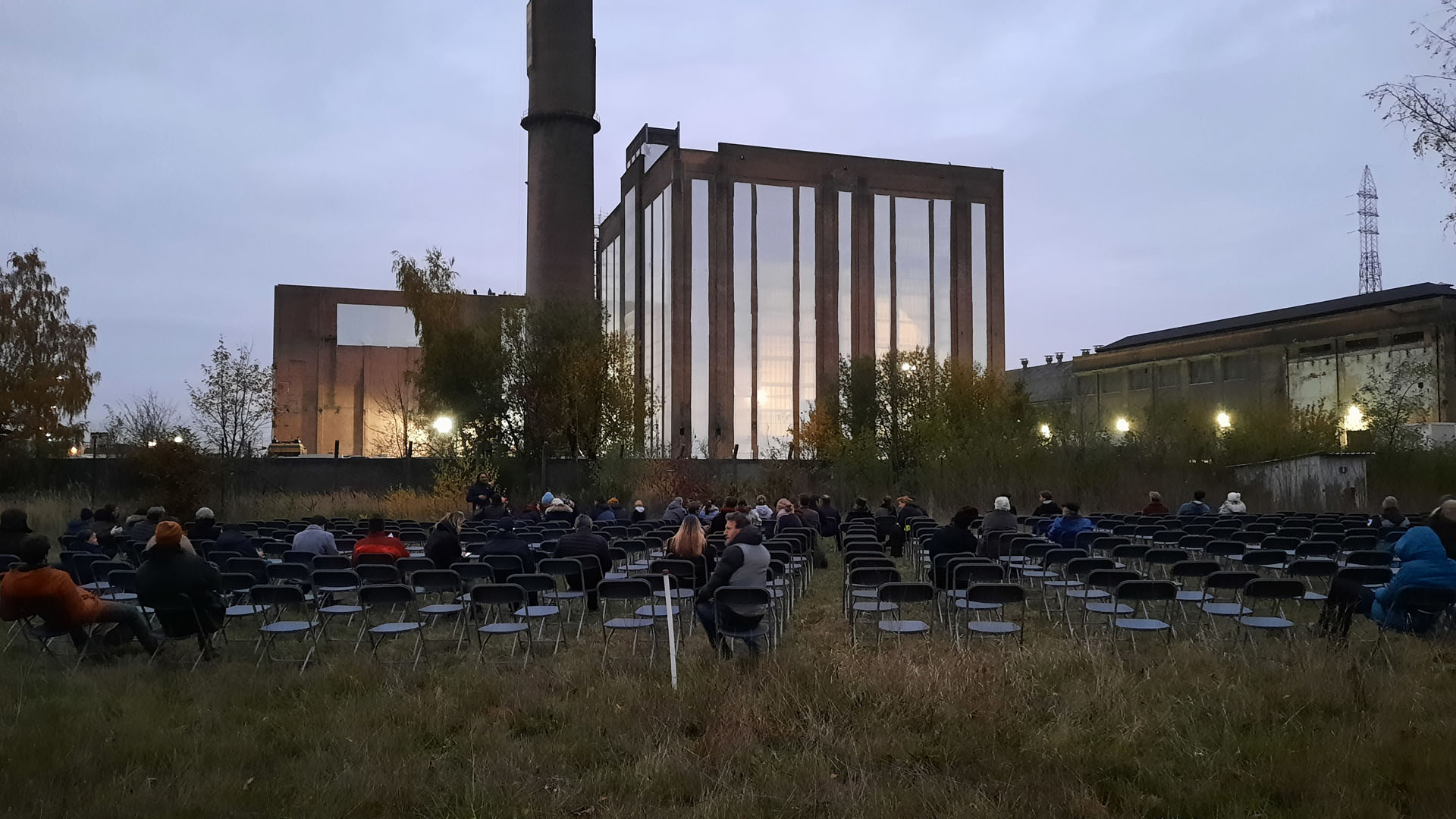
'Position 2 - View of the Langerbrugge Power Station' was part of the side program of the Ghent Light Festival 10 - 14 November 2021. It was a committed work of light art, part of a landscape triptych, that took you to the source of Ghent's urban lighting. By offering five hundred seats with a view of this 'Iron Cathedral' during sunrise and sunset, I did not only want to pay a sacred tribute to the building and its history. I was also referring to the societal risk that is in force in this area. Surrounded by heavy industry, an impressive setting was created in which the public was invited as silent witnesses of this situation. The work was part of 'Mission Dhuicque' and developed in close collaboration with Konnektor. With 'Mission Dhuicque' I want to pick up where architect-photographer Eugène Dhuicque left off. Namely identifying, signifying and protecting endangered heritage in various ways. In Langerbrugge (municipality Evergem) I focussed specifically on the decaying heritage of the power station. By using the Langerbrugge-South park area as an environment to ask questions, I tried to focus on the (silent) witnesses of this decline and their position in relation to this building.
What:
Participatory action
In collaboration with:
The people who witnessed the building during sunrise and sunset
Made possible by:
Gouvernement Ghent, Konnektor, Industrie Museum Ghent, Municipality Evergem, Den Hannekesnest, Engie, Arbo.jo, Rent2party.be and Light Festival Ghent.

'The Placing' (translated from Flemish 'De Zetting') was developed during a collaboration of one year with the people of social and artistic centre De Koer in Ghent. 'The Placing' was organized in a year of elections where the influence of right wing parties increased and in a neigborhood polarized around mobility policies. 'The Placing' was a collaborative sound work engaging these circumstances, an attempt to influence the inclusive experience of public space and offered an ode to the multilingualism of the Brugse Poort.
What:
Collaborative sound work
Where:
Brugse Poort, Ghent, Belgium
In collaboration with:
People of the neighborhood Brugse Poort and De Koer
Made possible by:
The City Ghent and Arts Flanders

'Gate Closed' was an artwork in the public space of Varna in Bulgaria. This temporary 'monument' was a hopeful comment on the poor infrastructural condition as a result of neglectance and corrupt governance. 'Gate Closed' appropriated the existing urban environment where brand new fences were placed around the ruins of a collapsed pedestrian tunnel. With small signs attached to these fences 'Gate Closed' was teasing the imagination of an unreachable but more beautiful reality on the other side of this tunnel.
What:
Intervention
Where:
Varna, Bulgaria
In collaboration with:
Hristina Tasheva

'Base camp Entre Nous' took three years to be developed and derived from the interesting history of 'The Society of Humanitarianism' (Maatschappij van Weldadigheid). This was a Dutch private organization set up in 1818 by army general Johannes van den Bosch. This utopian initiative aimed to help the poor families in the aftermath of the Napoleonic French occupation by granting them farming land. From the whole of the Netherlands people were sent to Drenthe in order to get a better life. This experiment eventually lost its public support but served as a model for the current Dutch welfare state. Today politicians argue that this model is also no longer efficient. Individual responsibilities in a participatory society is presented as the best solution. Base camp Entre Nous was a temporary laboratory in Frederiksoord, a test colony on the birth ground of the welfare state, here the search for new sustainable possibilities was leading. 'Base camp Entre Nous' was operational for one month and depended on the possibilities offered by a participatory approach, asking for a joint effort of private and public organisations and the expertise of people like you and me to make 'Base camp Entre Nous' possible and interesting. In the year 2019 I published a book (in Dutch) about this realization process.
What:
Partcipatory laboratory
Where:
Frederiksoord, Drenthe, Netherlands
In collaboration with:
Nils van Beek, Ingeborg Sturre, Sanne Morssink, Gabriël Micheneau & others (Foundation KIK Kunst in Kolderveen), Hristina Tasheva (photography), Tineke en Hijlco Komen, the people of Frederiksoord, (TAAK), (The Society of Humanitarianism), Vrouwk Weemstra & others ( Municipality Westerveld), Anne de Jong & others (Province Drenthe), (Ministry of Defense), the participating artists: Ivanka Annot, Egon Hanfstingl, Selby Gildemacher, Elise Leusink & Jeroen Gras, Erik Fakkeldij, Herma Schellingerhoudt, Richtje Reinsma, Iratxe Jaio & Klaas van Gorkum, Charlotte van Winden, Liesbeth Labeur, Erwin Van Doorn & Inge Nabuurs and Karin Bartels, Josien Pieterse and Anne de Zeeuw (Netwerk Democratie), Ferenc van Damme ('Participatie & Communicatie' provincie Overijssel), Henk Nijmeijer(100 jaar vrouwen kiezen), Daniel Kruithof (projectleider Vereniging van Nederlandse Gemeenten), Michelle Parlevliet (University professor Conflict Resolution and Governance aan de UvA Amsterdam), kolonel P.J.T.M. Hagenaars(Plaatsvervangend Commandant 43 Gemechaniseerde Brigade), Eric Versleijen, Ben van Bloemendal, Hans Jasperse (Veteranen Instituut), Anita van der Noord and Ko Henneman(de Nieuwe Leefstijl en Care for Sustainable Health), Dragoslav Milkovi´c (Teamleider Integratie Vluchtelingenwerk Noord–Nederland), Merhawit Gayem Shefare, Massoemeh Hosseini, Saleh Haj Asaad (representatives Vluchtelingenwerk Noord–Nederland), Mahmod Alkharat (photographer), Frans Kerver (boegbeeld @onsbasisinkomen), Petra Biemans (Lector HRM en Persoonlijk Ondernemerschap bij Hogeschool Inholland), Ronald Mulder (MIES), Rose Scholten (MEE Drenthe), Lambert Smit (Drenthe College), Klaas Smidt (wethouder gemeente Westerveld), Dette Glashouwer(theatermaker), Ralf Embrechts (initiatiefnemer Quiet500),Hub Crijns (oprichter Arme Kant van Nederland/EVA), Ulfert Molenhuis (voorzitter van de Voedselbank), Tanja Geurtsen (municipality Westerveld) and Yvonne Turenhout (CMO STAMM en het Sociaal Planbureau Groningen), Peter Everts (Creative Council Noord Nederland), Marloes de Bie (Bibit), Marcel Tankink (partner van KAW), Marieke Vegt (directeur K&C), Monica Boekholt (voormalig CBK Assen), Anne de Jong (provincie Drenthe, beleidsadviseur Cultuur, Maatschappij en Vrijetijdseconomie), Jeroen van Westen (artist) and Janine Hogeman (project leader landgoed Terheijl municipality Noordenveld), Harry Tupan (director Drents Museum), Michiel van der Kaaij (project leader Kunst in de Openbare Ruimte bij K&C), vertegenwoordigers van Dorpsbelang Vledder en Dorpscoöperatie Hollandscheveld verbindt, Yvonne Witter (adviseur Aedes-Actiz Kenniscentrum Wonen-Zorg), Paulien Melis en Janine Huizinga (Creative Care Lab van de Waag Society), Marja van Vliet (Positieve Gezondheid), Ellen Bos (Value 2 Share), Inge Vuijk (Rehab Academy), Marjet van Houten (Movisie), Drentalenten (Provincie Drenthe), Martijn Arnoldus (Voor je Buurt), Derk (Jan) Stobbelaar (Duurzaam Landschapsbeheer Hogeschool Van Hall Larenstein), Stephan van Duin (bioloog), Wouter Mensink(auteur van het boek: Kun je een betere wereld kopen?), Merel Melief (Roeg & Roem), represantatives of Zuhause, Sjors de Vries (Ruimtevolk),Paul Hendriksen (o.a. Tiny Houses Coöperatie), Luit Hummel(BOKD), Jennifer Petterson (documentairemaker), Joost de Bloois (Filosoof en docent Literary and Cultural Analysis van de UvA Amsterdam), Albert Elken (directeur van de Burg. W.A. Storkschool in Dwingeloo), representatives of Coop De Buitenschool,Ecodorp Noordeland, ORKZ (Oude Rooms Katholieke Ziekenhuis Groningen, Bolderburen en Ronald Hunneman (lecturer at Kunsten, Cultuur en Media(KCM) at RUG Groningen) and many others...
Made possible by:
The Province Drenthe, The DOEN Foundation, BPD Cultuurfonds and Mondriaan Fund
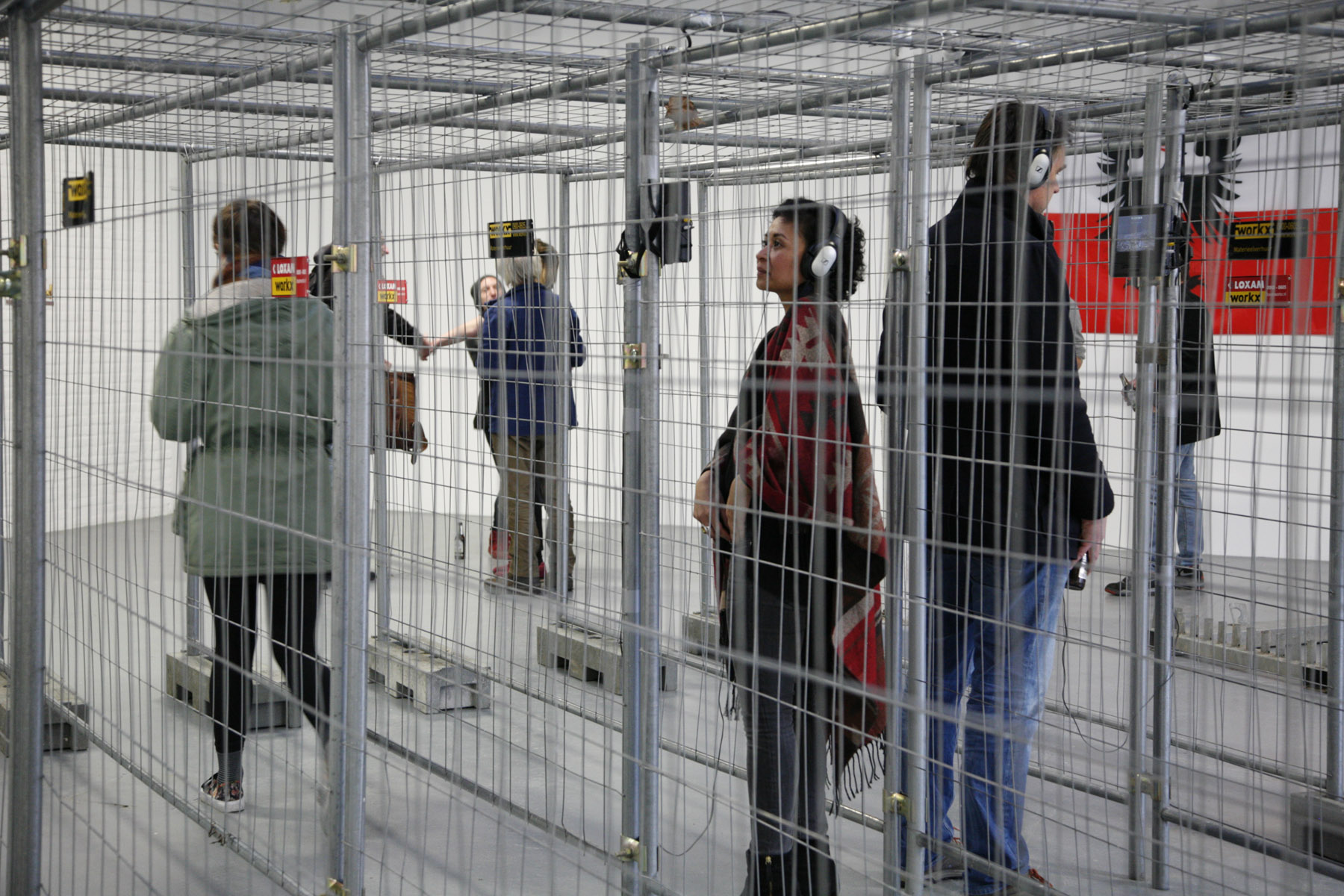
'The Centre of Now' consisted of several readymade and festival-related materials arranged together in the white cube. 'The Centre of Now' explored the notion of festivals and the meaning of visitors within these environments of control and could be seen as a critique towards the political and economic instrumentalization of culture within these settings.
What:
Installation / Arrangement
Where:
Deventer, Netherlands
Made possible by:
Kunstenlab
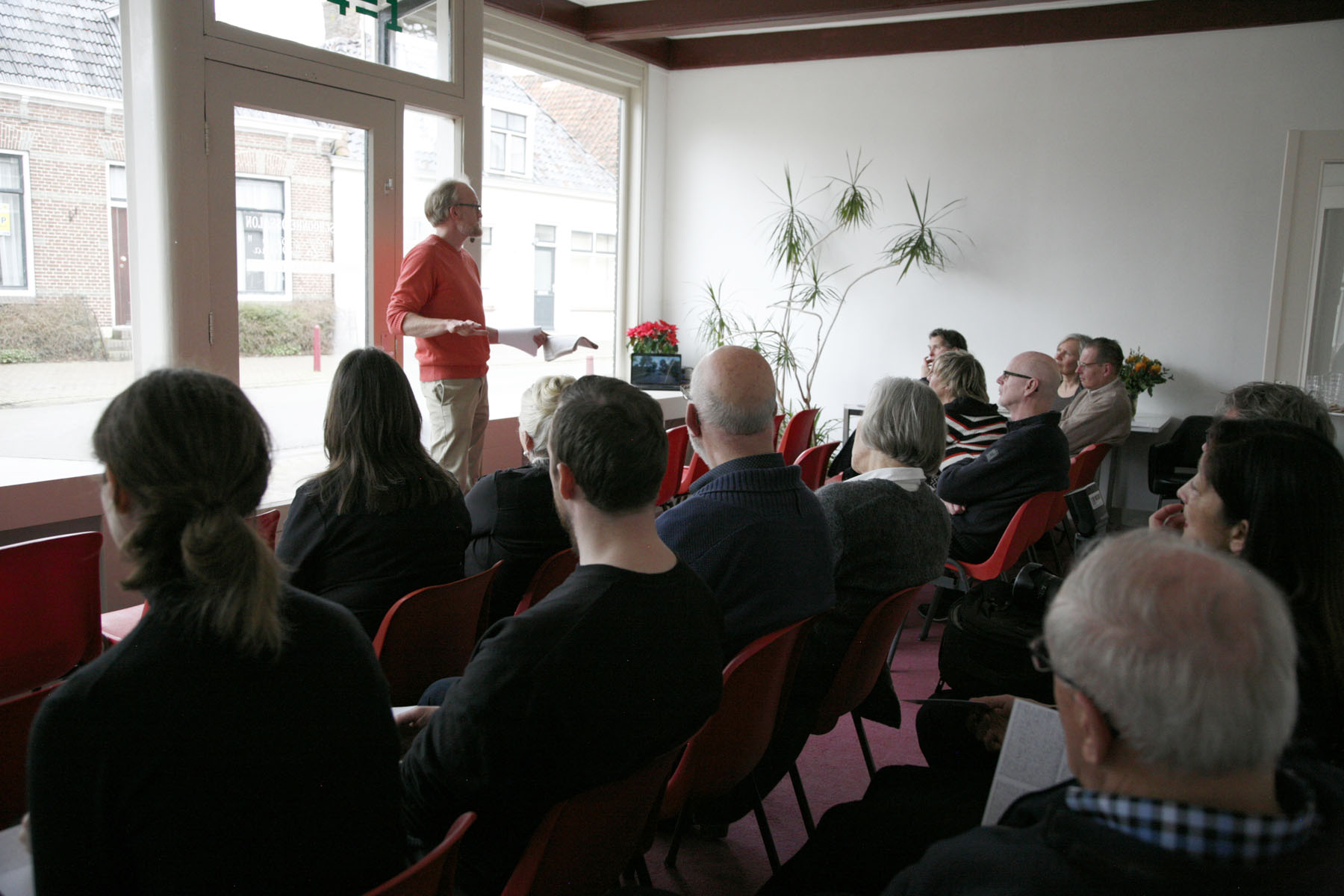
'5 – 4 = 1' was a theatrical representation of the Arriva bus driver as an artist. This site specific work was based on nine-Dutch translations by Louwrien Wijers of statements which the artist Joseph Beuys did when he was for nine days in Japan. Text 5 is about economic culture, minus text 4 that deals with the creative potential we all have, this asks for text 1 our widening perception of an artistic practise. '5 – 4 = 1' was offering a possible solution to approach todays fragmentation. It was a play about the possibility of the bus driver seen as an artist, using the potential of the bus as a common place for development and inner growth.
What:
Theatrical representation
Where:
Guest studio Louwrien Wijers, Ferwerd, Netherlands
In collaboration with:
Louwrien Wijers, Egon Hanfstingl, Hristina Tasheva, people of the municipality Ferwerd, gym De Heechfinne, Arriva
Made possible by:
Mondriaan Fund
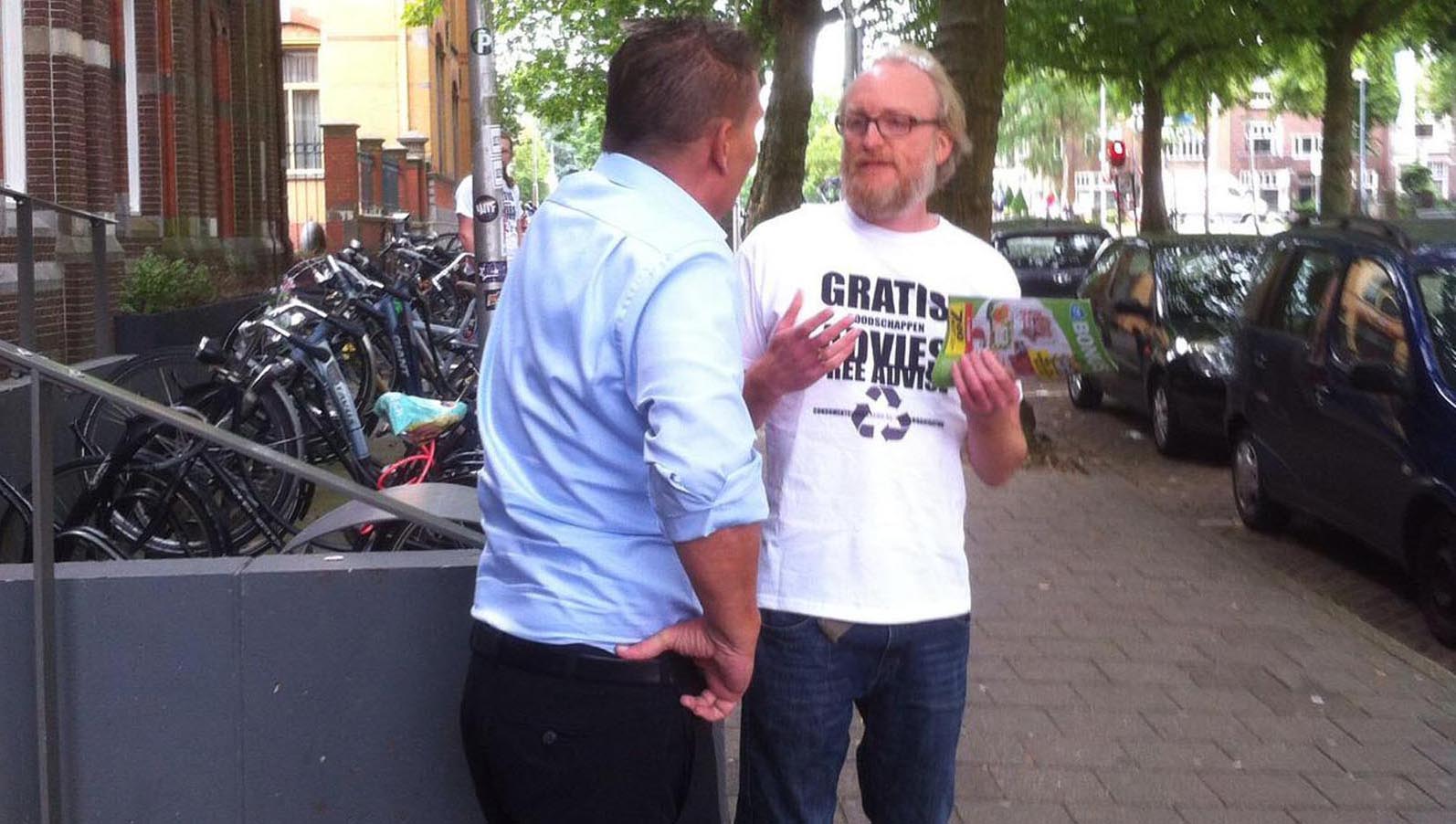
'Denial-of-Service' (DoS) was inspired by the characteristics of a Distributed Denial of Service (DDos) attack that we know from the virtual world. By integrating this strategy in the real world 'Denial-of-Service' researched the possibilities for customers to influence the highly controlled shopping experience. From the outside of a supermarket three performers tried to convince people to buy a discounted pineapple and to generate collaborativly an out of stock experience. 'Denial-of-Service' organized a rupture in the visual appearance of commercial strategies.
What:
Collaborative action
Where:
Supermarket, Nijmegen, Netherlands
In collaboration with:
Frans van Lent, Youri Appelo, Caz Egelie and the people of the Unnoticed Art Festival
Made possible by:
Unnoticed Art Festival

I witnessed an open call for artists living in Utrecht to participate in the group show: Under Control. Location for this exhibition on control was the former prison at Wolvenplein in Utrecht. While this prison was waiting for a new owner the Central Government Real Estate Agency (owner of the building) gave it a temporary cultural destination. This cheap approach safeguarded the building from squatters. An artist fee for the participating artists of this show was missing while visitors had to pay an entrance fee. Within this context I used my appointed prison cell as infrastructure for private meetings to discuss the necessity for new collaborative strategies.
What:
Performance
Where:
Wolvenplein Prison, Utrecht, Netherlands
In collaboration with:
the people of Kunstliefde and Utrecht Down Under
Made possible by:
Kunstliefde
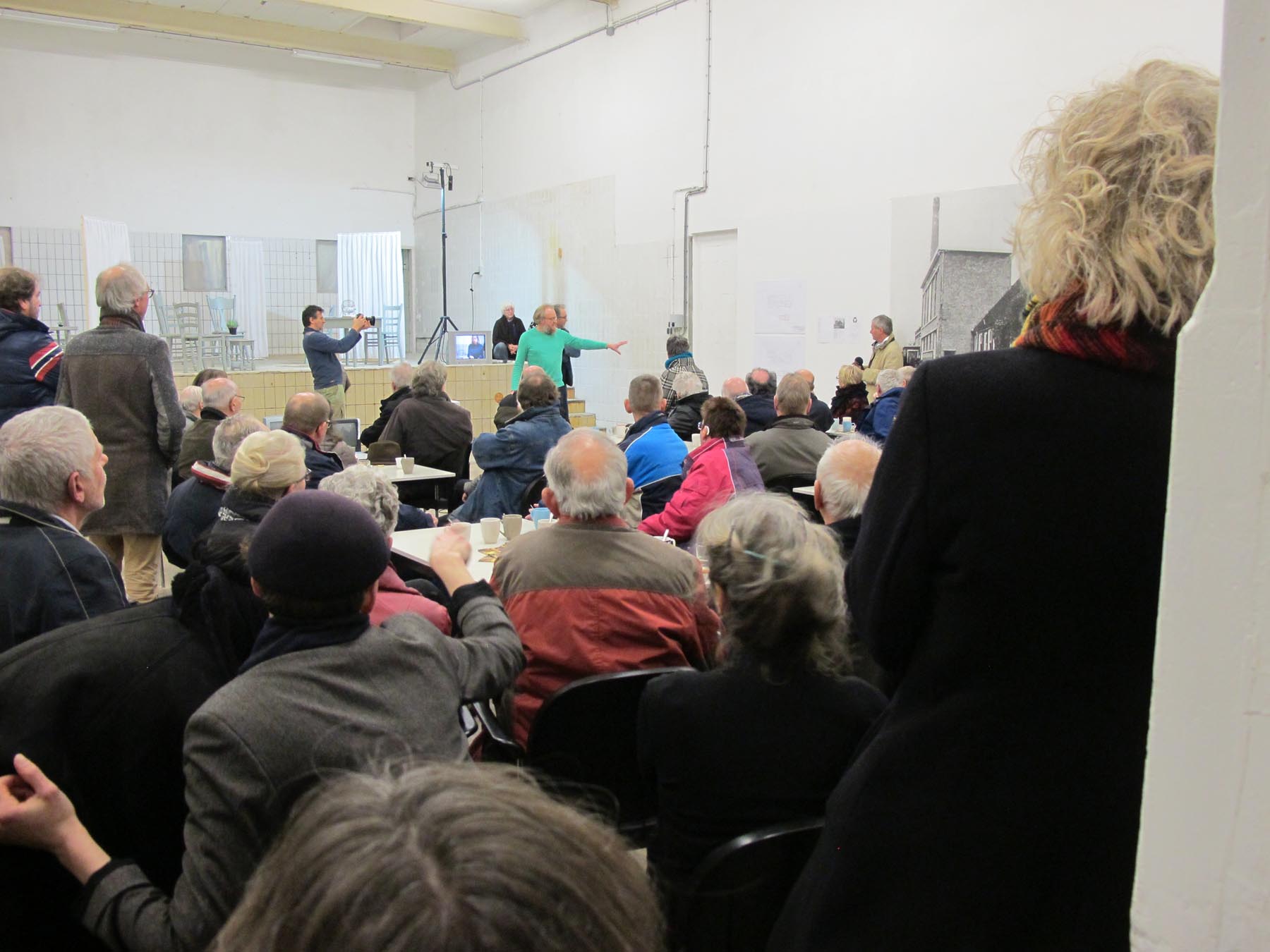
'The Sound of Coöp. Dairy 'De Venen' took one year to be developed together with Foundation KiK. The final sound work (plus an exhibition) was realized during a two months Mondriaan residency in this former dairy in Kolderveen. 'The sound of Coöp. Dairy De Venen' dealt with the question if we were able to bring back the sound of the past in the industrial heritage of today? By bringing this question into practice I created the shared possibility to experience and learn from its consequences. In 1995 this dairy had to close because of economic scaling. Today there are private apartments and some small companies housed in the building. Together with local people and former employers I made a sound map and collected speakers and receivers. With a sound technician we recorded the different sounds at the dairy in Rouveen that is still operational today. The current inhabitants of the building were asked to open up their houses for the sounds that belonged there in the past. This dialogue-based process also revealed the human consequences of economic scaling. Working at the dairy had delivered them a strong social structure that vanished after the closing. Some people still live in a house that once was owned by the cooperation. Some people never found another job after the closing of the dairy. 'The Sound of Coöp. Dairy 'De Venen' offered the former employers not only a warm reunion but also the powerful statement of reclaiming this dairy for half an hour, witnessed by an audience, with the production sounds of the past.
What:
Collaborative sound work
Where:
Coöp. Dairy De Venen, Kolderveen, Netherlands
In collaboration with:
Pim Trooster, Ingeborg Sturre, Meilof Koster, the volunteers of Foundation KiK, Annette Lubbers (communication), Michiel de Boer (sound technician), BOEi, De Historische Vereniging Nijeveen, with special thanks to: Lourens Schipper, Arend Thissingh, former employees of dairy 'De Venen', with special thanks to: Aaltje Pals, Gerard Lutke and his wife, Frans Stoker, Dhr Jelsma, Geert Bouwknecht, Albert Manden, Ron Oosterveen, Rouveen Kaasspecialiteiten with special thanks to: Justin Koster, inhabitants of Coop. Dairy 'De Venen' with special thanks to: Aart Oostergetel, Loes Heebink, Hillie en Arend Kikkert, Oene van der Zee, Gerard Schulenberg, Steven van der Gaauw, artists in the exhibition thought-experiment: Arjan Brentjes, Chaja Hertog & Nir Nadler, Erik Sep, Floris Kaayk, Giorgi Tabatadze, Hristina Tasheva, Klaas Jonkman, Krijn de Koning, Marieke Coppens, Marijn Ottenhof, Nina Glockner, Norman Beierle, Sil Krol, RTV Drenthe, Kringloopwinkel Meppel, Kringloopwinkel De Kring Meppel, Stichting Kringloop Zwolle Zuid, Kringloop Nieuwe Veerallee Zwolle, Bertus Roodhof, Stina v/d Ploeg
Made possible by:
Foundation KiK, Foundation BOEi, Mondraan Fund
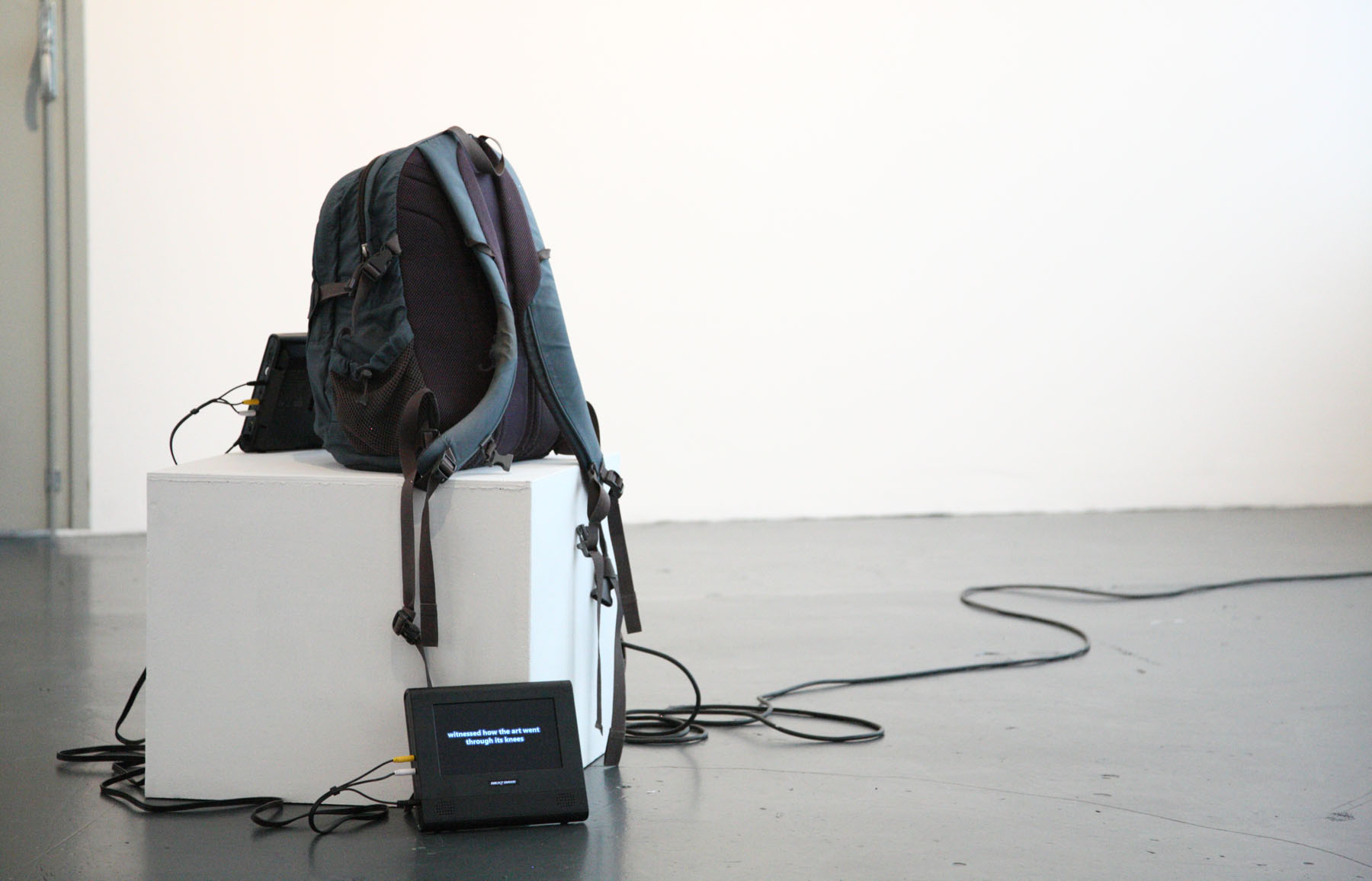
'Not a Readymade' consisted of my backpack placed on a pedistal in a white cube setting. This group exhibition showed the work of several art bloggers and their view on art. With my contribution I played with the value of art in a controlled white cube environment. Presenting my backpack challenged the relationship between art en everyday life. The first you hear when entering a museum is that backpacks are not allowed.
What:
Video installation
Where:
Stichting Ruimtevaart, The Hague, Netherlands
In collaboration with:
Kees Koomen and the people of Foundation Ruimtevaart
Made possible by:
Stichting Ruimtevaart
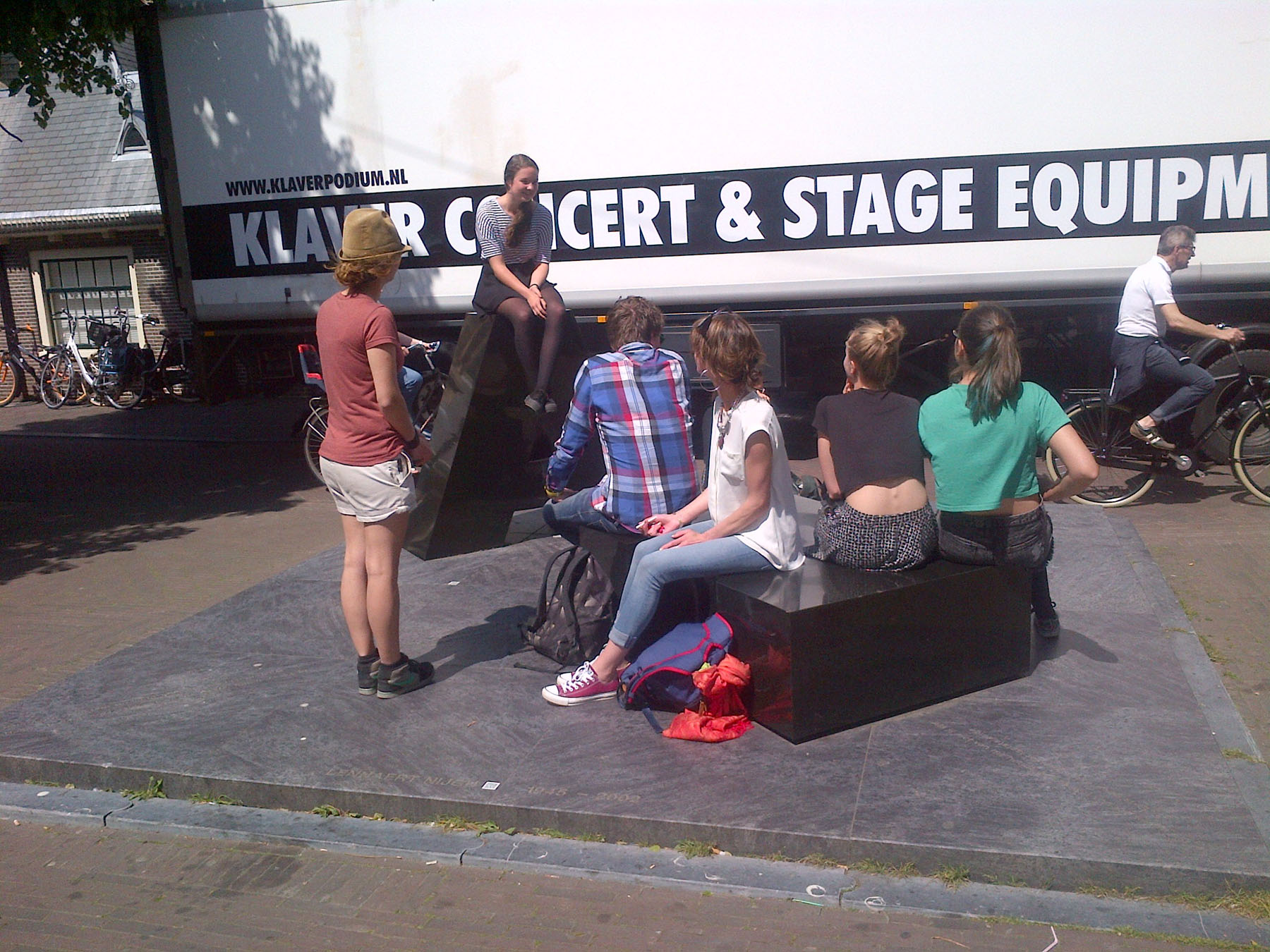
'Couch grass' was a group performance of nine youngsters which seemed to be loitering around in the city centre of Haarlem. In 'reality' each youngster prepared beforehand a subject of their interest and expertise. While the people stigmatized their visual presence as loitering youngsters in the street, they focused on the exchange of their knowledge.
What:
Performance
Where:
Haarlem, Netherlands
In collaboration with:
Frans van Lent, Jutka Vries, Ella Nieuwenhuijzen, Marlot Westera, Eveline de Jonge, Diedrik Sibma, Bo van den Heuvel, Shane Hoetjes, Mickey Vissers and Folkert Koelewijn
Made possible by:
The Unnoticed Art Festival

'24/7_Trojan' started with my fascination for the almost unreachable little park in the middle of the large roundabout called 'Het Keizer Karel plein' in Nijmegen. Curator Stijn Van Dorpe asked me to respond with my work on a text by the philosopher Jaques Rancière: "The power of a way of thinking has above all to do with its ability to move." In close agreement with the people of Expoplu I wrote my proposal in a letter to the alderman of Culture, Mobility and Education officially asking for permission. My proposal to make this city park accessible by foot was unfortunately rejected. From here all further communication with the city officials was deliberately blocked by them. After this rejection I started to interact with the actual circumstances within my possibilities and in a wide variety of ways.
What:
Collaborative action
Where:
Roundabout, Nijmegen, Netherlands
In collaboration with:
Stijn Van Dorpe, Angela Vissers, Anita Waltman, Mariska van den Berg, Joost de Bloois, Aglaée Degros, Feico Hoekstra, Lucette ter Borg, local politicians from Green Left, VVD and D66 and the board of Expoplu
Made possible by:
Expoplu
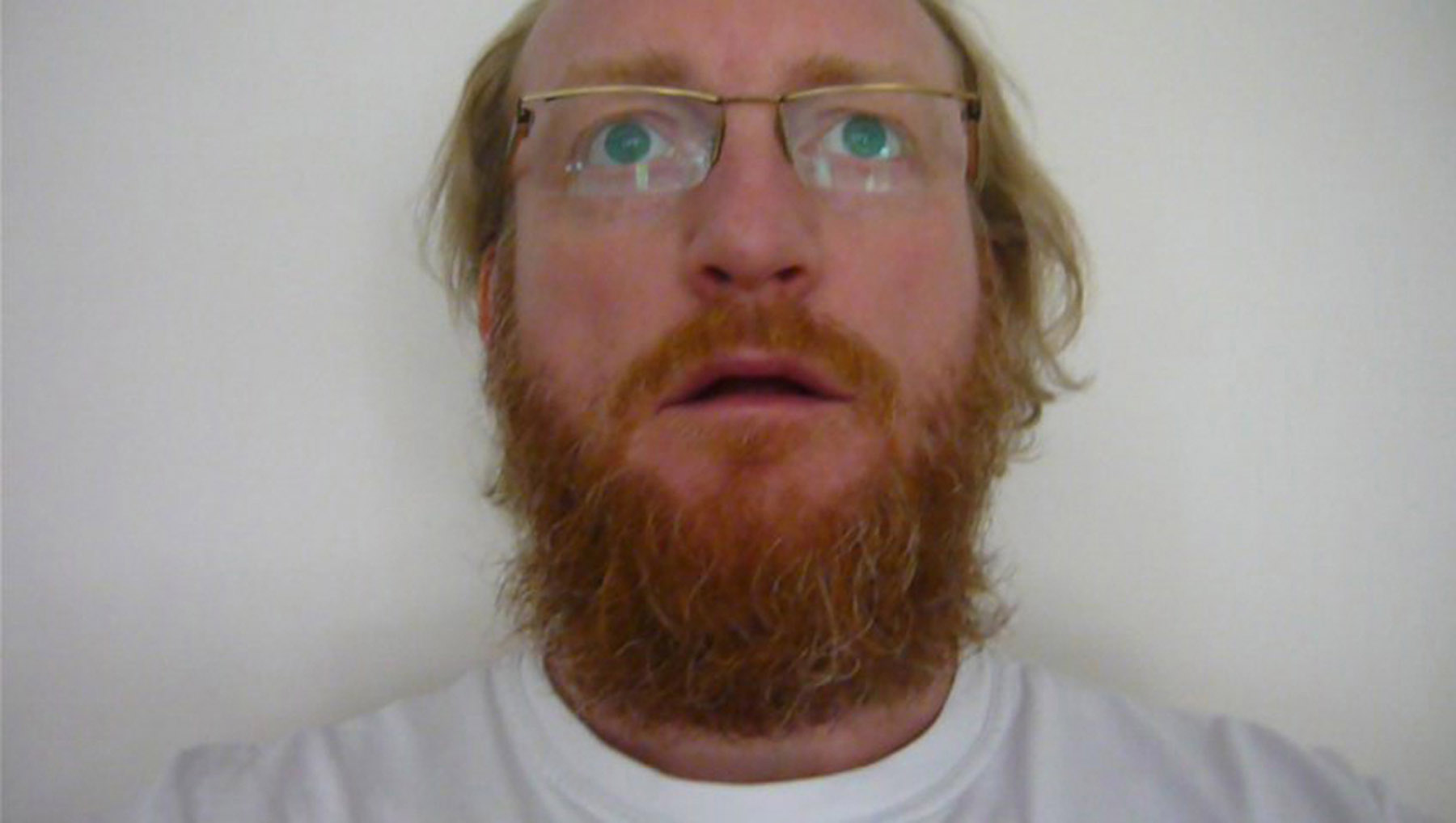
'Conjuncture of circumstances' is a sound and video performance that is shared online where I imitate a trumpet playing: Taptoe-signal. This signal is played in the Netherlands at 'Remembrance of the Dead' that is held annually on May 4th. This trumpet signal commemorates all civilians and members of the armed forces of the Kingdom of the Netherlands who have died in wars or peacekeeping missions since the beginning of the Second World War. 'Conjuncture of circumstances' reacted on the political climate in the Netherlands and its growing hostility against minority groups.
What:
Sound & Video performance
Where:
Servicegarage, Amsterdam, Netherlands & Online
Made possible by:
The Servicegarage & Sandberg Institute
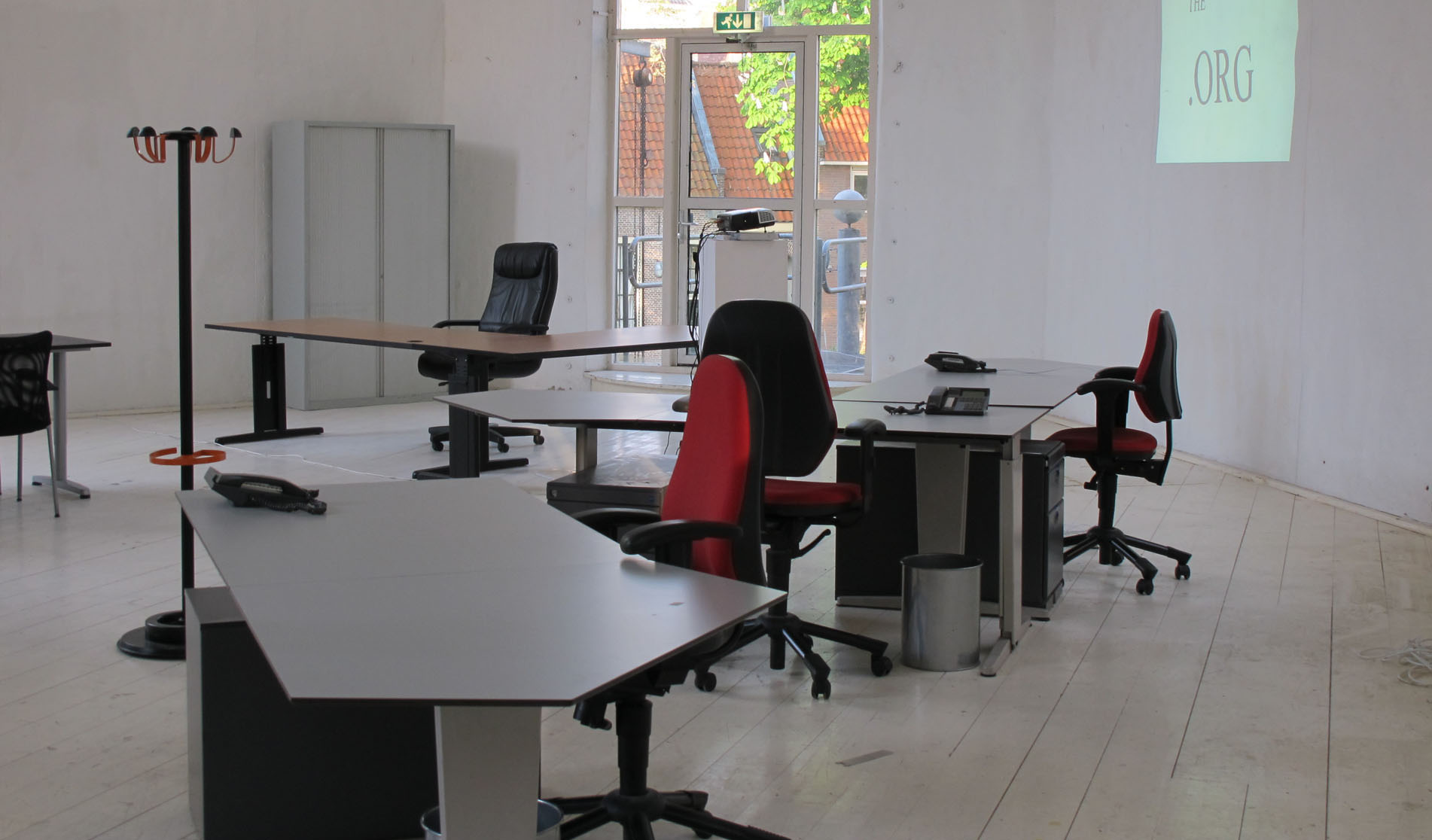
'The Organisation Office' tried to transform the isolated white cube into an infrastructure with a common function. With this 'open office', realized with the help of local companies, it created a work space availble for the people of Hoorn. 'The Organisation Office' researched the role and function of art and how it relates to the social causes outside the art category.
What:
Material action
Where:
HMK | Hotel MariaKapel, Hoorn, Netherlands
In collaboration with:
The people of HMK | Hotel Maria Kapel, Kantoormeubel recycling, Budget Display and Hristina Tasheva
Made possible by:
Mondriaan Fund
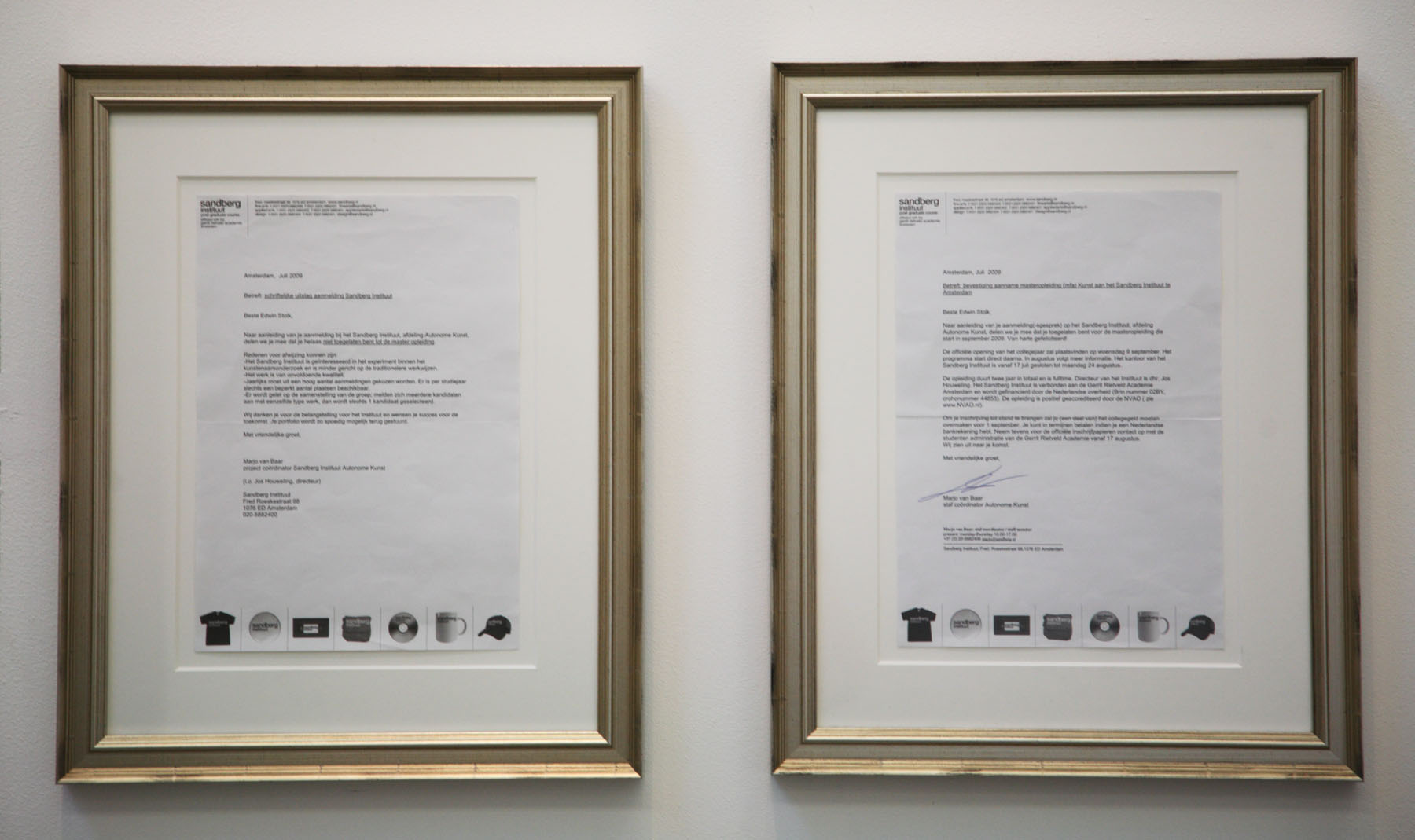
'The Void' was part of the group show 'We Will Never Know for Sure' by Sandberg Institute students at W139 in Amsterdam. My contribution was deliberately questioning the showing of art, the role of the artist who is showing and the art venue as place to show art. 'The Void' consisted of several different elements like walks, talks, presentations, videos and other web-based content.
What:
Situation
Where:
W139, Amsterdam, Netherlands
Made possible by:
W139 & the Sandberg Institute
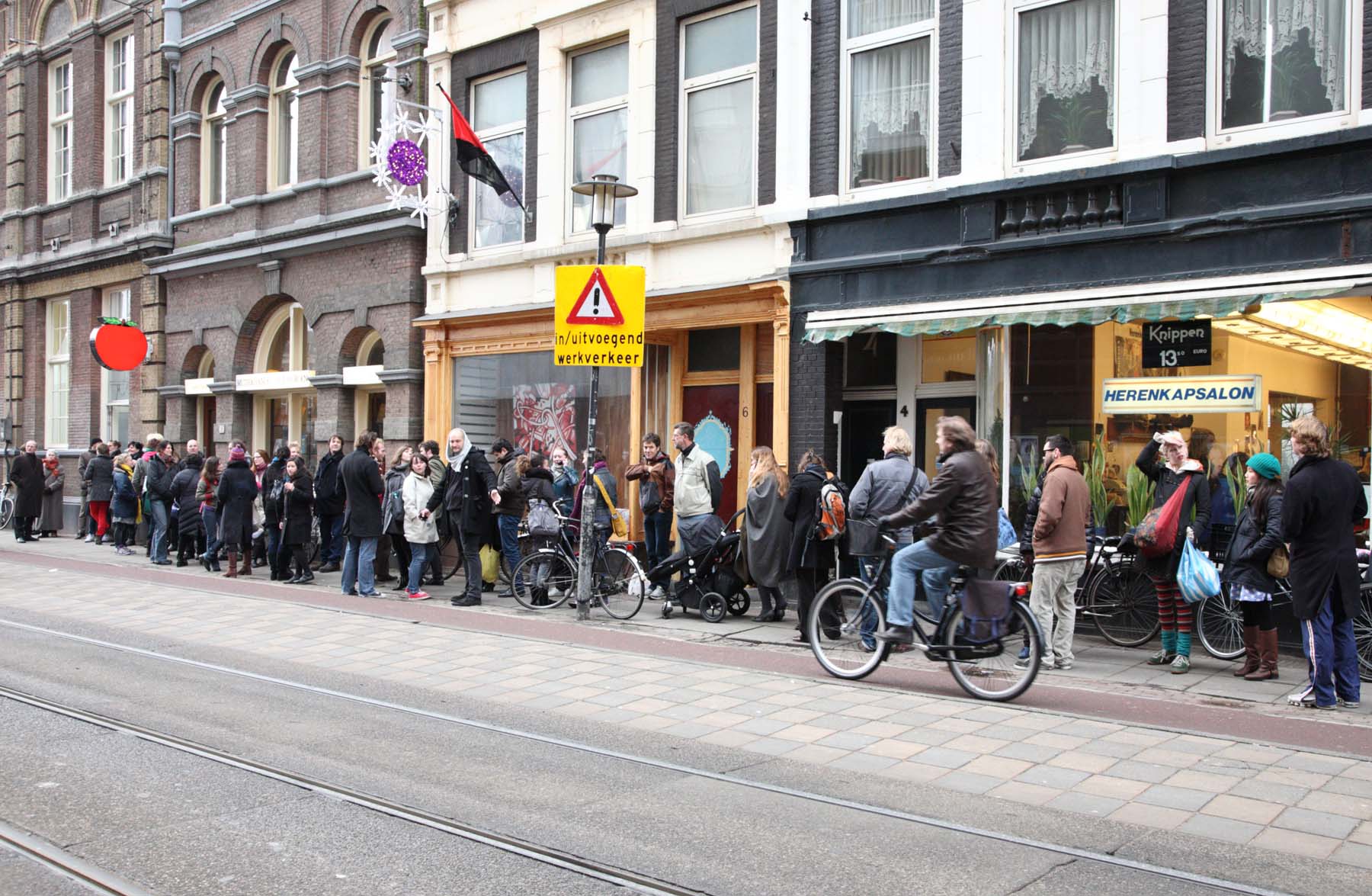
'A Life Changing Experience' was inspired by statements of the former state secretary of education and culture Halbe Zijlstra (VVD politician) in the Netherlands. He announced on public television to make governmental subsidies for museums depended on visitor ratings. At the same time the Appel Art Centre was publicly accused in a newspaper to attract only a small group of insiders at their exhibition openings. In response to this news I invited people to join me at 3 pm on a Saturday and to stand for 30 minutes in front of the pay desk in the heart of this art museum in Amsterdam. Together we formed a large queue that reached far outside the museum. After half an hour everybody left and disappeared in the city.'A Life Changing Experience' showed the possibilities for collaborative action in times of individualization.
What:
Collaborative action/ Human arrangement
Where:
Appel Art Centre, Amsterdam, Netherlands
In collaboration with:
Loek Grootjans, Alicia Framis, Lucette ter Borg, Hristina Tasheva and the people of the Sandberg Institute, everyone sharing the call on and offline and all the participants who answered this call and were queuing all together
Made possible by:
The Sandberg Institute, Appel Art Centre and all the participants

'The Hanging Gardens of Babylon' investigated the nature in a Euro 2000 protected reservation in a dune area nearby Heemskerk. Inspired by the famous painting 'The Hanging Gardens of Babylon', painted by the Heemskerk born Maarten van Heemskerck. This painting is depicting one of the Seven Wonders of the World. These gardens were built by Nebuchadnezzar II, the Chaldean king, in about 600 BC as a consolation to his Median wife, who missed the natural surroundings of her homeland. It brought me to the idea to turn this concept around and bring what is considered outside the nature here into this reserve. 'The Hanging Gardens of Babylon' fueled a lively debate when fences, cars, containers and other materials were exhibited in the dunes.
What:
Material action / arrangement
Where:
Heemskerk, Netherlands
In collaboration with:
Jaap Velserboer and Ronald Tebra, Stichting Beeldende Kunst Manifestatie Heemskerk, The North Dutch water company, Car dealers Klok & Thissen and Poelenburg, Multimade Heemskerk, MIK meubel interieur Koevoets, Hristina Tasheva and all the volunteers who helped to make this intervention possible
Made possible by:
Stichting Beeldende Kunst Manifestatie Heemskerk
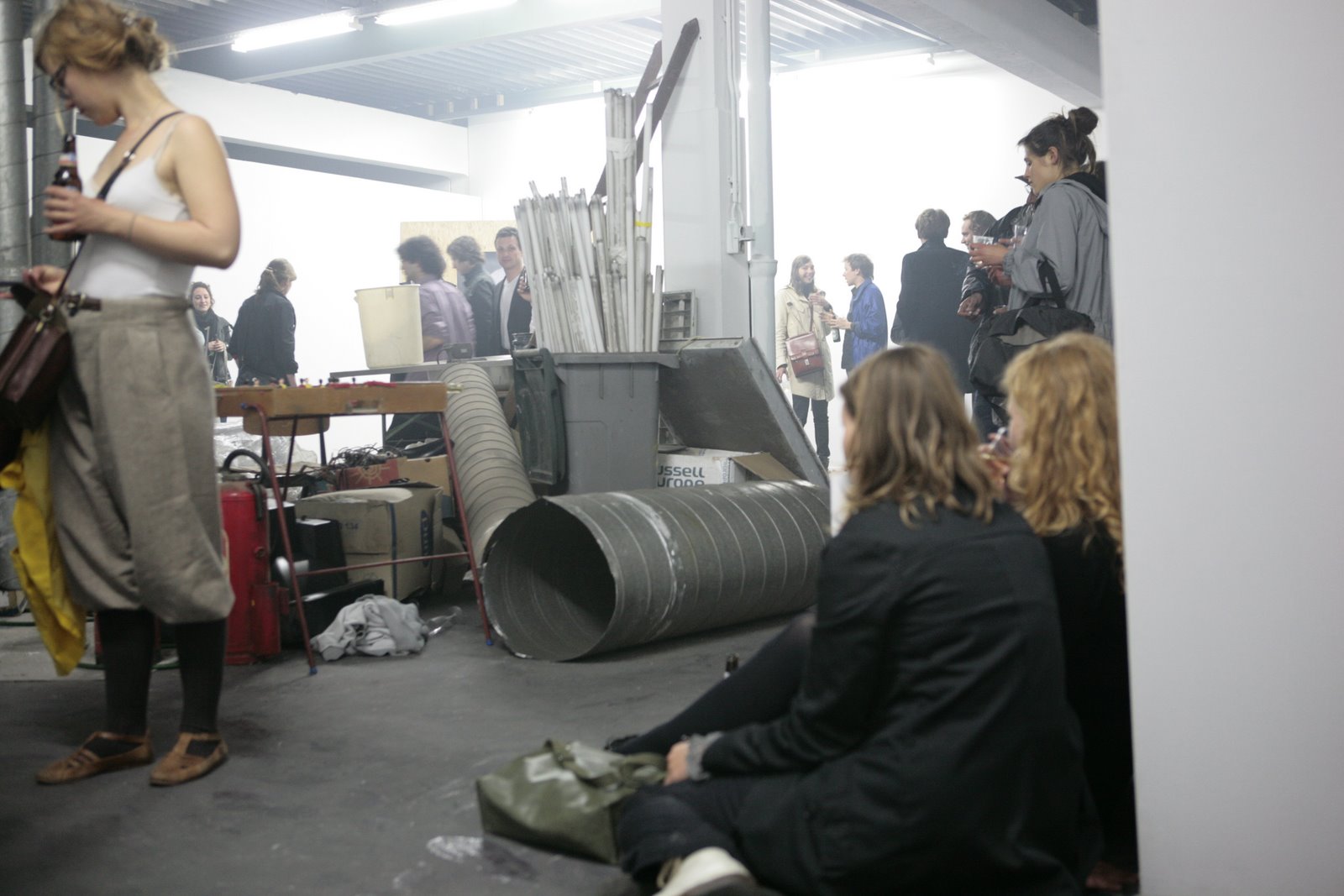
'WAR OF CURRENTS _eliminator of possibilities' was a material action undermining and addressing the 'white cube' as a manipulative space. The Servicegarage was a former Citroën garage and I collected all available materials that referred to this past and arranged them in the white exhibition space that was created here for art. 'War of Currents' was a statement that art should be able to resist the forces of life and not being presented as isolated objects of (commercial) desire. 'War of Currents' claimed the attention for new artistic currents and questioned contemporary art in (protected & commercialized) art venues - seen as the 'eliminator of possibilities'.
What:
Material action
Where:
De Servicegarage, Amsterdam, Netherlands
In collaboration with:
Ehsan Fardjadniya, Frank Ammerlaan and the people of the Servicegarage
Made possible by:
De Servicegarage
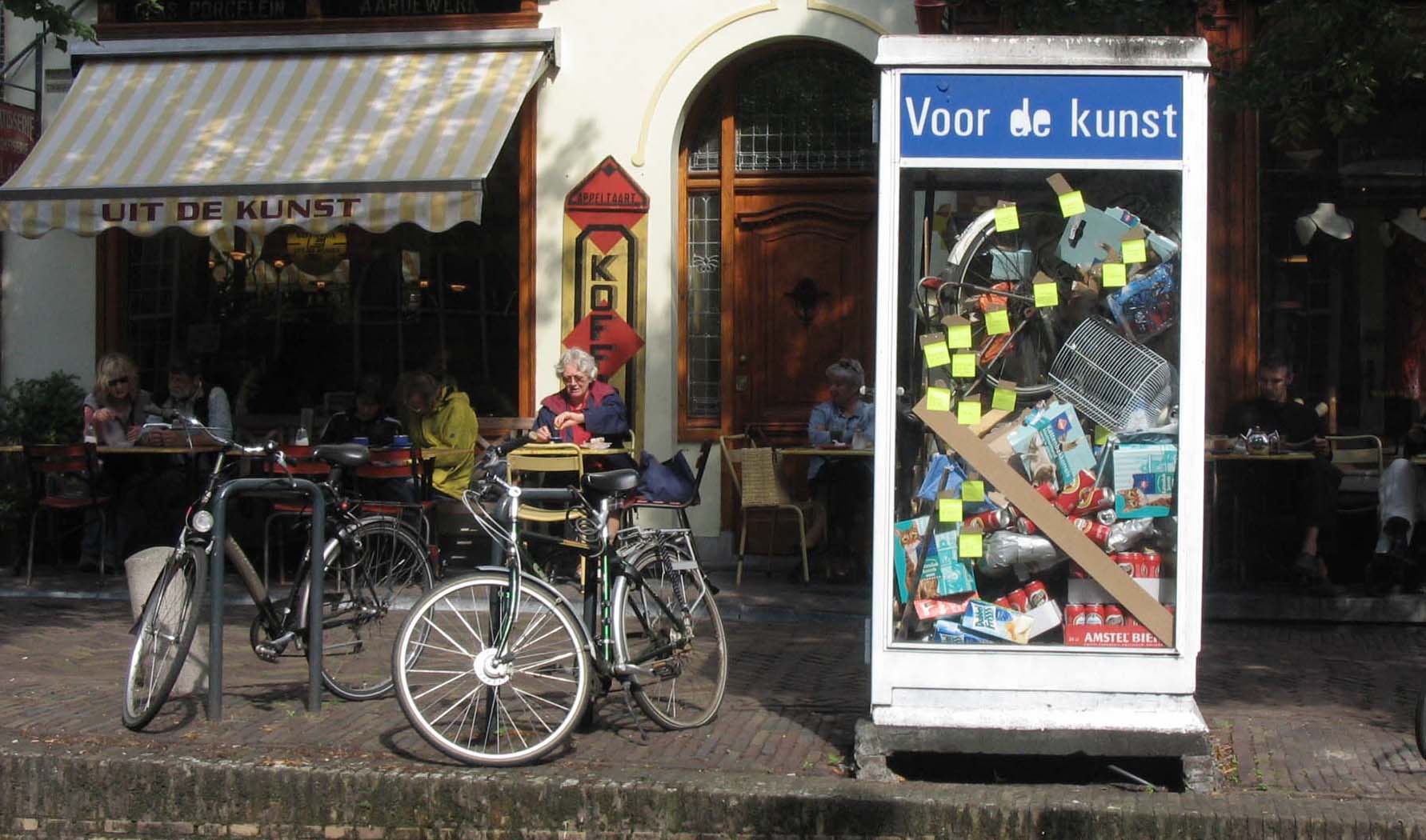
'Lets Feed Ice-cream to the Rats' searched for different ways to start a dialogue between a work of art and its surrounding. For this specific occasion I collected waste and arranged these materials inside an old phone booth in Delft that was especially reserved for art. I attached post-its on the windows that provoked a variety of responses.
What:
Material action / Situation
Where:
Voor de Kunst, Delft, Netherlands
In collaboration with:
Els Cornelis
Made possible by:
Voor de Kunst
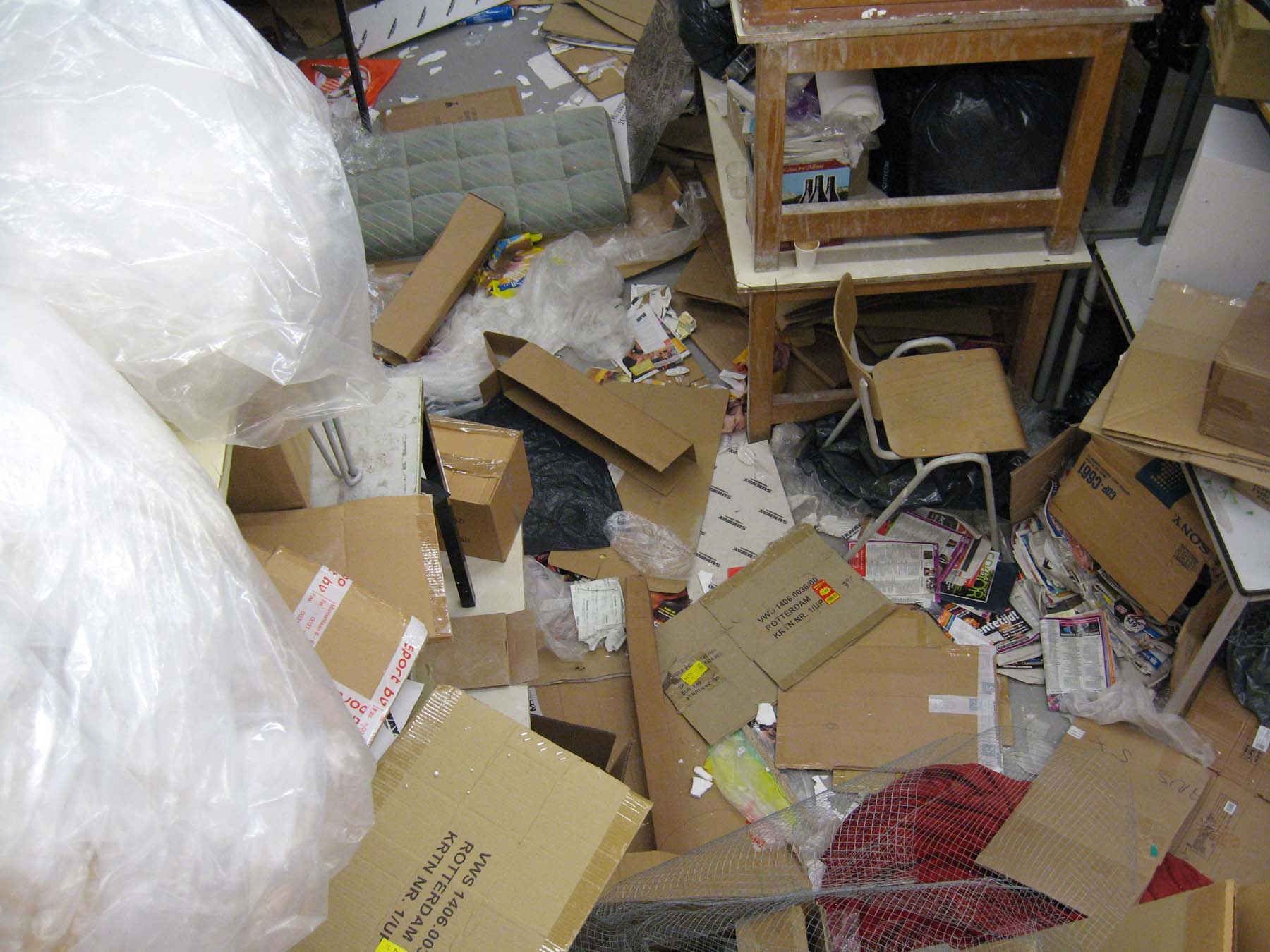
While the Royal Academy of Art in The Hague was preparing for the annual graduation show, 'Not 4 U' exhibited everything that was removed from the building to establish clean white cube environments. In a large installation in the basement of the academy all the excluded materials, tables, cupboards and chairs formed a 'reality' that visitors were not supposed to see. 'Not 4 U' dealt with the ordered surrounding, the meaning of art in manipulated spaces and the general concept of 'reality'.
What:
Material action/ arrangement
Where:
The Royal Academy of Art, The Hague, Netherlands
Made possible by:
The Royal Academy of Art



















